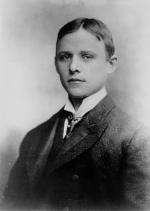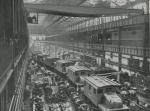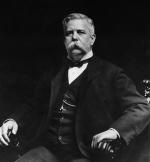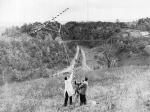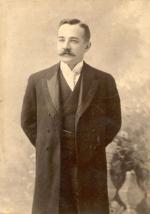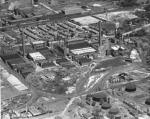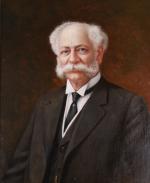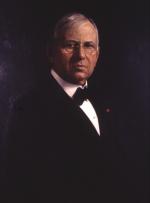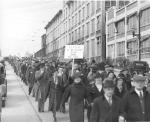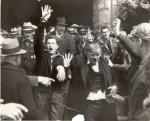Chapter 3: Inventors and Entrepreneurs
The ability to take an invention or an idea and build an enduring business enterprise from it requires a diverse set of skills that are lumped together in the term entrepreneurship. Not all inventors are good entrepreneurs; often it requires the talents of several individuals to turn an invention into an industry. For example,  Charles Martin Hall discovered a process for making aluminum when he was a twenty-two year old chemistry graduate of Oberlin College. Hall then attempted to develop his process, but his need for money and technical expertise led him to Pittsburgh. There he found Alfred Hunt, a consulting engineer to the steel industry, who provided much needed advice and money. His most important contribution, though, was to hire Arthur Vining Davis, who would be responsible for making the Aluminum Company of America a highly successful company and a monopoly for half a century.
Charles Martin Hall discovered a process for making aluminum when he was a twenty-two year old chemistry graduate of Oberlin College. Hall then attempted to develop his process, but his need for money and technical expertise led him to Pittsburgh. There he found Alfred Hunt, a consulting engineer to the steel industry, who provided much needed advice and money. His most important contribution, though, was to hire Arthur Vining Davis, who would be responsible for making the Aluminum Company of America a highly successful company and a monopoly for half a century.
In contrast, George Westinghouse demonstrated that he could both invent and organize. In the 1860s, he invented an automatic air brake system for trains to replace hand-operated brakes on each car. To make his invention a success, he had to design and engineer a complex system that was guaranteed to work every time. After developing his air brake, he next had to sell it to railroad managers who were not enthusiastic about adopting a new and expensive technology. In this case he succeeded by convincing the public that air brakes would make passenger trains safer.
George Westinghouse demonstrated that he could both invent and organize. In the 1860s, he invented an automatic air brake system for trains to replace hand-operated brakes on each car. To make his invention a success, he had to design and engineer a complex system that was guaranteed to work every time. After developing his air brake, he next had to sell it to railroad managers who were not enthusiastic about adopting a new and expensive technology. In this case he succeeded by convincing the public that air brakes would make passenger trains safer.
When Westinghouse next decided to develop alternating current electricity, he left the inventing to others and concentrated on engineering a practical system. His successful system, along with a similar one developed by General Electric, made it possible to provide electricity to the nation's homes and factories. By the 1930s the only Americans without electricity were many of the nation's farmers. Private companies argued that it was too expensive to construct miles of power lines to serve only a few customers.
Philadelphia engineer Morris L. Cooke convinced President Franklin D. Roosevelt in 1935 to establish a Rural Electrification Administration to provide financial assistance to farmers who organized cooperatives to supply their own power lines. This program allowed many Pennsylvania farmers to enjoy electric lighting and other appliances that other Americans already took for granted.
Rural Electrification Administration to provide financial assistance to farmers who organized cooperatives to supply their own power lines. This program allowed many Pennsylvania farmers to enjoy electric lighting and other appliances that other Americans already took for granted.
After World War II, the new appliance that everyone wanted was television. Watching television soon became one of Americans' favorite leisure pursuits, but many potential viewers did not buy sets because mountains prevented them from receiving TV signals. This was the situation in Mahanoy City until appliance store owner John Walson ran a cable from an antenna atop a nearby mountain to his shop. Soon, residents of the town were requesting cable television. Seizing the opportunity, Walson organized the Service Electric Company which became a pioneer in the field.
cable television. Seizing the opportunity, Walson organized the Service Electric Company which became a pioneer in the field.
For entrepreneurs, Europe remained, at least until World War I, a source of new technologies. Ever since the first colonists arrived, Americans had borrowed -or stolen- European developments, including textile machinery and steam locomotives. As a teenager in Philadelphia, W. Atlee Burpee, instead of following his father into medicine, became fascinated with selective animal breeding. After starting a mail order poultry business, he diversified into vegetable and flower seeds. In the 1880s Europe was the center of scientific plant development, so every year Burpee traveled there to find plants to introduce to Americans. The need to adapt these plants to American conditions led him to establish his own experimental farms, which soon became a source of new plant varieties, such as his highly popular Fordhook lima bean.
W. Atlee Burpee, instead of following his father into medicine, became fascinated with selective animal breeding. After starting a mail order poultry business, he diversified into vegetable and flower seeds. In the 1880s Europe was the center of scientific plant development, so every year Burpee traveled there to find plants to introduce to Americans. The need to adapt these plants to American conditions led him to establish his own experimental farms, which soon became a source of new plant varieties, such as his highly popular Fordhook lima bean.
Candy entrepreneur Milton S. Hershey already had a successful caramel business when at the 1893 World's Fair in Chicago he saw German machines for producing milk chocolate in large batches. Betting his future on this new technology, he purchased machines and began to mass produce his famous Hershey Bar, which made his company the first large chocolate firm in America. Sometimes, Europeans established businesses in the United States to avoid paying tariffs and to take advantage of growing purchasing power of the average American.
Milton S. Hershey already had a successful caramel business when at the 1893 World's Fair in Chicago he saw German machines for producing milk chocolate in large batches. Betting his future on this new technology, he purchased machines and began to mass produce his famous Hershey Bar, which made his company the first large chocolate firm in America. Sometimes, Europeans established businesses in the United States to avoid paying tariffs and to take advantage of growing purchasing power of the average American.
In 1911 the British textile firm Courtaulds constructed a rayon plant on the Delaware River south of Philadelphia. The popularity of the glamorous but inexpensive new fiber made this a very profitable beginning for the American Viscose Company, which remained the nation's largest rayon producer until the 1950s. The growth of the relatively prosperous American urban middle class did not escape businessmen who desired to make products that would appeal to this important segment of the population.
American Viscose Company, which remained the nation's largest rayon producer until the 1950s. The growth of the relatively prosperous American urban middle class did not escape businessmen who desired to make products that would appeal to this important segment of the population.
In Pittsburgh, Henry J. Heinz discovered that his clear glass bottles of horseradish found favor with women who valued convenience and cleanliness. Capitalizing on these values, Heinz created a processed food empire by assuring consumers that his products were of the highest quality. He even supported the Pure Food and Drug Act of 1904, hoping that government regulation would help convince the public that the unsanitary practices described in Upton Sinclair's expose of the meat packing industry, The Jungle, were not characteristic of the industry generally. Like other businessmen, Heinz hired engineers and scientists to make sure his products met his standards and to develop new or improved foods. Heinz realized that the trust of the consumer was his greatest asset.
Henry J. Heinz discovered that his clear glass bottles of horseradish found favor with women who valued convenience and cleanliness. Capitalizing on these values, Heinz created a processed food empire by assuring consumers that his products were of the highest quality. He even supported the Pure Food and Drug Act of 1904, hoping that government regulation would help convince the public that the unsanitary practices described in Upton Sinclair's expose of the meat packing industry, The Jungle, were not characteristic of the industry generally. Like other businessmen, Heinz hired engineers and scientists to make sure his products met his standards and to develop new or improved foods. Heinz realized that the trust of the consumer was his greatest asset.
Winning over consumers was also the goal of urban merchants in rapidly expanding American cities. In the decades after the Civil War, department stores, large consumer palaces that sold a wide variety of goods, appeared in American cities. John Wanamaker was the pioneer in this field in Philadelphia. Shoppers flocked to his store to take in its elegant ambience and take advantage of the lower prices that a large-scale merchant could offer. To further win over the largely middle-class clientele, he sold his goods at set prices, eliminating the traditional haggling that many modern shoppers found unseemly. Also to gain trust, he allowed customers to return merchandize if they were unhappy with it. By winning over the urban shopper, Wanamaker became a highly successful businessman.
John Wanamaker was the pioneer in this field in Philadelphia. Shoppers flocked to his store to take in its elegant ambience and take advantage of the lower prices that a large-scale merchant could offer. To further win over the largely middle-class clientele, he sold his goods at set prices, eliminating the traditional haggling that many modern shoppers found unseemly. Also to gain trust, he allowed customers to return merchandize if they were unhappy with it. By winning over the urban shopper, Wanamaker became a highly successful businessman.
Using a strategy that had much in common with Wanamaker, Fred Morgan Kirby was pioneer in Five and Dime stores, which classified goods according to price. Selling a large variety of low-priced goods, the Five and Dime store became a merchandizing phenomenon around the turn of the twentieth century.
Fred Morgan Kirby was pioneer in Five and Dime stores, which classified goods according to price. Selling a large variety of low-priced goods, the Five and Dime store became a merchandizing phenomenon around the turn of the twentieth century.
Although entrepreneurs were mainly recognized for the businesses they founded, many were deeply involved in their communities and left large sums of money to local or national philanthropic institutions. Sometimes businessmen built entire towns to attract workers. Milton Hershey designed the village of Hershey to be a pleasant and attractive place to live. It was even permeated with the smell of chocolate coming from the adjacent factory. Hershey was indeed generous to his company town, but he also expected deference from his workers.
In 1937, however, when a sit-down strike occurred in the plant led by workers seeking union elections, other Hershey employees and local citizens forcibly cleared the strikers from the plant. That the union lost a subsequent election demonstrated the effectiveness of Hershey's paternalism, at a time when many industries were becoming unionized. Remarkably, Hershey left most of his assets, including controlling interest in the company, to a school for orphans that he had founded.
sit-down strike occurred in the plant led by workers seeking union elections, other Hershey employees and local citizens forcibly cleared the strikers from the plant. That the union lost a subsequent election demonstrated the effectiveness of Hershey's paternalism, at a time when many industries were becoming unionized. Remarkably, Hershey left most of his assets, including controlling interest in the company, to a school for orphans that he had founded.
Company towns and private philanthropy reflected the enormous power of wealthy businessmen to shape society in ways that they deemed desirable. Of course, their priorities were not always the same as other citizens of the state. Hershey was just one of the entrepreneurs whose works and legacies have had a lasting influence on Pennsylvania.
In contrast,
When Westinghouse next decided to develop alternating current electricity, he left the inventing to others and concentrated on engineering a practical system. His successful system, along with a similar one developed by General Electric, made it possible to provide electricity to the nation's homes and factories. By the 1930s the only Americans without electricity were many of the nation's farmers. Private companies argued that it was too expensive to construct miles of power lines to serve only a few customers.
Philadelphia engineer Morris L. Cooke convinced President Franklin D. Roosevelt in 1935 to establish a
After World War II, the new appliance that everyone wanted was television. Watching television soon became one of Americans' favorite leisure pursuits, but many potential viewers did not buy sets because mountains prevented them from receiving TV signals. This was the situation in Mahanoy City until appliance store owner John Walson ran a cable from an antenna atop a nearby mountain to his shop. Soon, residents of the town were requesting
For entrepreneurs, Europe remained, at least until World War I, a source of new technologies. Ever since the first colonists arrived, Americans had borrowed -or stolen- European developments, including textile machinery and steam locomotives. As a teenager in Philadelphia,
Candy entrepreneur
In 1911 the British textile firm Courtaulds constructed a rayon plant on the Delaware River south of Philadelphia. The popularity of the glamorous but inexpensive new fiber made this a very profitable beginning for the
In Pittsburgh,
Winning over consumers was also the goal of urban merchants in rapidly expanding American cities. In the decades after the Civil War, department stores, large consumer palaces that sold a wide variety of goods, appeared in American cities.
Using a strategy that had much in common with Wanamaker,
Although entrepreneurs were mainly recognized for the businesses they founded, many were deeply involved in their communities and left large sums of money to local or national philanthropic institutions. Sometimes businessmen built entire towns to attract workers. Milton Hershey designed the village of Hershey to be a pleasant and attractive place to live. It was even permeated with the smell of chocolate coming from the adjacent factory. Hershey was indeed generous to his company town, but he also expected deference from his workers.
In 1937, however, when a
Company towns and private philanthropy reflected the enormous power of wealthy businessmen to shape society in ways that they deemed desirable. Of course, their priorities were not always the same as other citizens of the state. Hershey was just one of the entrepreneurs whose works and legacies have had a lasting influence on Pennsylvania.









